Headlines and Hashtags
What Happened in Mingjing Village?

Mingjing Village.
The breaking story of a shooting at a supermarket in Boulder, Colorado, on Monday afternoon made headlines across the United States and around the world. Many outlets in the US have followed with live updates, and in the days to come there will surely be further reports and analysis asking a crucial question: Why?
The treatment of the Colorado story by US and international media starkly contrasts with the reporting of a story unfolding the very same day on the outskirts of the southern Chinese city of Guangzhou – the detonation of a bomb in a historic village, killing five and injuring five others. In this case, there were no big headlines. There were no reporters on the scene. There was only a trickle of information, including a pair of terse local police notices, a news item from the state-run Xinhua News Agency that parroted the police line, and a graphic video of the aftermath circulating with little context on social media.
Today the Guangzhou story has settled into eerie silence across the Chinese media landscape. News editors are reportedly under instructions to use only official copy from Xinhua — ensuring that if the story is told at all, it is told only in the way the authorities see fit.
Left with only hints as to what might have happened in the Mingjing Village (明经村), what can we learn?
Explosion at a “Building Structure”?
Some of the first details from the scene in Panyu emerged at 12:48 PM Monday, nearly three hours after a man identified as “Hu XX” (胡某), age 59, apparently set off an explosion Mingjing Village, located in Panyu District, about 25 kilometers southeast of the city center of Guangzhou.
Few of these details were included in the first official announcement from police in Panyu, posted to Weibo. Reporting only a “criminal incident,” the release read:
At around 10AM on March 22, a criminal incident occurred in Mingjing Village, Hualong Township, Panyu District, Guangzhou City, resulting in casualties. After the incident, Panyu police quickly dispatched officers to the scene, carrying out rescue and relief work in coordination with the local government, the fire department and medical [personnel]. Currently, the injured have been sent to the hospital for rescue and treatment, and police are putting their full energies into the investigation.
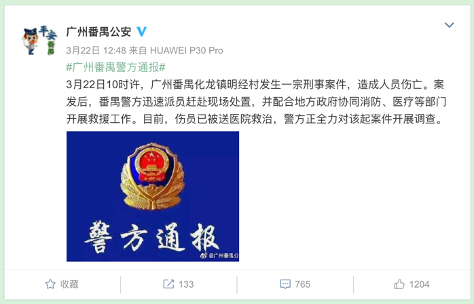
In typical fashion for Chinese government (and official media) reporting of breaking stories, the focus was on the actions authorities were taking, and few details were forthcoming. Later that night, more than 10 hours after the explosion, the local police again provided information through Weibo:
At around 10AM on March 22, a criminal incident occurred in Mingjing Village, Hualong Township, Panyu District, Guangzhou City. After Panyu Police received a report, they quickly began an investigation.
Through preliminary investigation [it is understood that] suspect Hu XX (male, 59 years old, from Panyu District, Guangzhou City) carried explosive materials on the morning of that day into a building structure in the village, resulting in the death of 5 people, including suspect Hu XX, and the injury of 5.
Currently, all injured have been sent to the hospital for treatment, and the case is under further investigation.
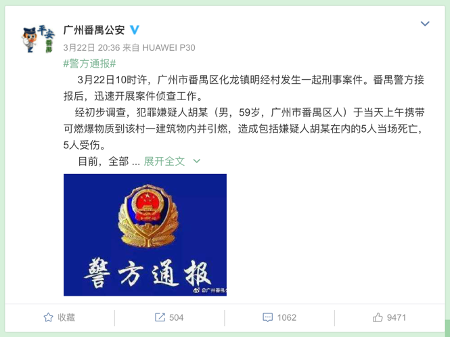
The statement from Panyu police was quickly carried by a number of online outlets in China, including the website of the National Business Daily, which ran it along with a screenshot of the Weibo post. It was shared verbatim hours later by Xinhua News Agency. It was now clear that the case involved the unidentified “Hu XX,” who had carried explosive materials into “a building structure” (一建筑物).
This odd detail was a clear clue that something was seriously wrong, and that the authorities were being exceptionally careful about how they characterized the incident.
Interestingly, the report from the Reuters news agency on the explosion in Panyu, relying primarily on Xinhua’s verbatim repetition of police accounts, also described the explosion as having occurred at a “building in the Mingjing area,” though it noted several paragraphs down that “local media reports described the building as housing a community committee.”
Map searches suggest Mingjing Village is a relatively remote community, well to the east of the center of Panyu, a bustling satellite of Guangzhou proper that has been known in the past as a center for rights defense activity – including bitter land disputes over the years, as the urban fabric of the Guangzhou megalopolis has expanded. But the area around Mingjing Village has been developing rapidly, and those familiar with village politics in the Pearl River Delta region might surmise that this incident was related to a land dispute. Indeed, it seems to have been exactly that. We’ll come to the details in a moment.
First things first, what about this “building structure”?
At 3:05PM, in fact, about five hours after the explosion occurred, The Beijing News, a commercial paper based in the capital that since 2011 has fallen under the management of the local propaganda department but for many years has fought to maintain its professional reporting, posted a story online drawing on the initial police release as well as phone conversations with local villagers and township police. It was a rare instance of a journalist actually reporting substance:
The Beijing News reports (Reporter, Liu Ruiming) – The Panyu branch of the Guangzhou Public Security Bureau issued a release saying that a criminal case occurred in Mingjing Village in Guangzhou’s Panyu District, resulting in casualties. On March 22, villagers from Mingjing Village at the scene of the incident told the reporter that the site of the incident was the office building of the Mingjing Village Committee, and that there was a suspected explosion with casualties. An employee at the Hualong [Township] police substation, located in the area where the incident occurred, told the reporter that the substation had already dispatched officers to the scene of the bombing at the Mingjing Village Committee.
Attack on the Village Committee
As to why the committee building had been targeted, the report was not clear. It went further in describing the scene, however, using eyewitness video and accounts from local villagers:
The video shows severe damage to the interior of the first floor of a building, with columns and walls collapsing and people falling to the ground with injuries. Police, fire and emergency personnel have arrived to deal with the scene.
A villager from Mingjing where the incident occurred told the reporter from The Beijing News that it was believed an explosion had occurred on the second floor of the village committee building at around 10AM on March 22. “My home is only two or three buildings away from the village committee, after hearing the sound of the explosion, I went to the scene to see for myself.”
The villager said that at the scene they saw that there was broken glass everywhere on the floor the first level of the committee building, the doors and walls inside were all damaged, and people were being sent off for rescue and treatment. After public security officers arrived at the scene, a cordon was drawn around the area and personnel were on the scene to investigate.
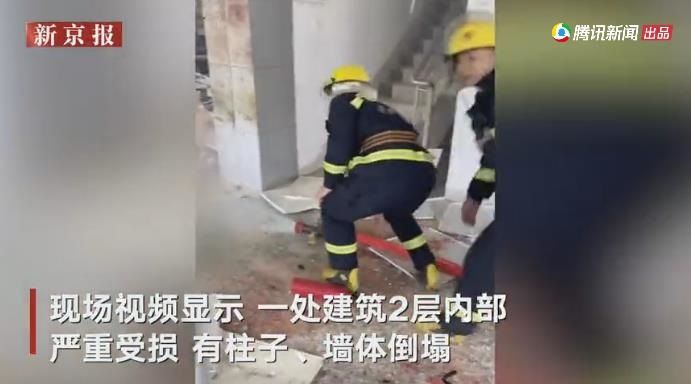
The report from The Beijing News came almost five hours before the second release from police in Panyu, referring evasively to “a building structure.” A search of the Wisenews database, covering print and online media in China and Hong Kong, shows that only the Information Times and New Express, both based in Guangzhou, have run the story of the Mingjing Village explosion today. In both cases, the papers use only information from the Panyu police notices, mentioning that an explosion occurred and that the suspect “Hu XX” had been identified, but continuing to report that the explosion had occurred in “a building structure.”
On Monday afternoon, video from the scene of the explosion, the same referenced by The Beijing News, was shared on social media platforms, with the majority of posts appearing to share information only from the police notices, and referring to “the second floor of a building structure.” The following post from the Headline News (头条新闻) Weibo account, for example, closely follows the release, making no mention of the committee building. The post was made about 30 minutes before The Beijing News released its report.
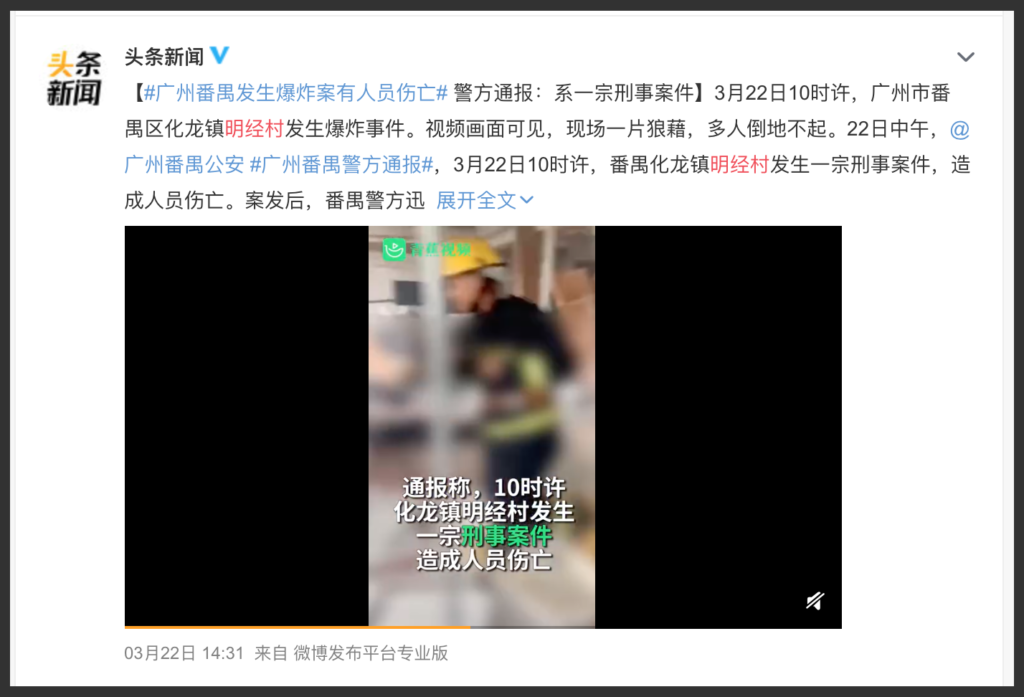
However, a number of social media posts later in the afternoon, following the report from The Beijing News, did mention the village committee. The following post, made to Weibo by Cover News (封面新闻) just before 8PM Monday, reads:
Reportedly, the site of the explosion is the Mingjing Village Committee. Villagers near the site of the incident say that the Mingjing Village Committee holds a regular village affairs meeting every Monday in the morning, attended by the village secretary, the deputy village secretary, the security chief and other cadres.
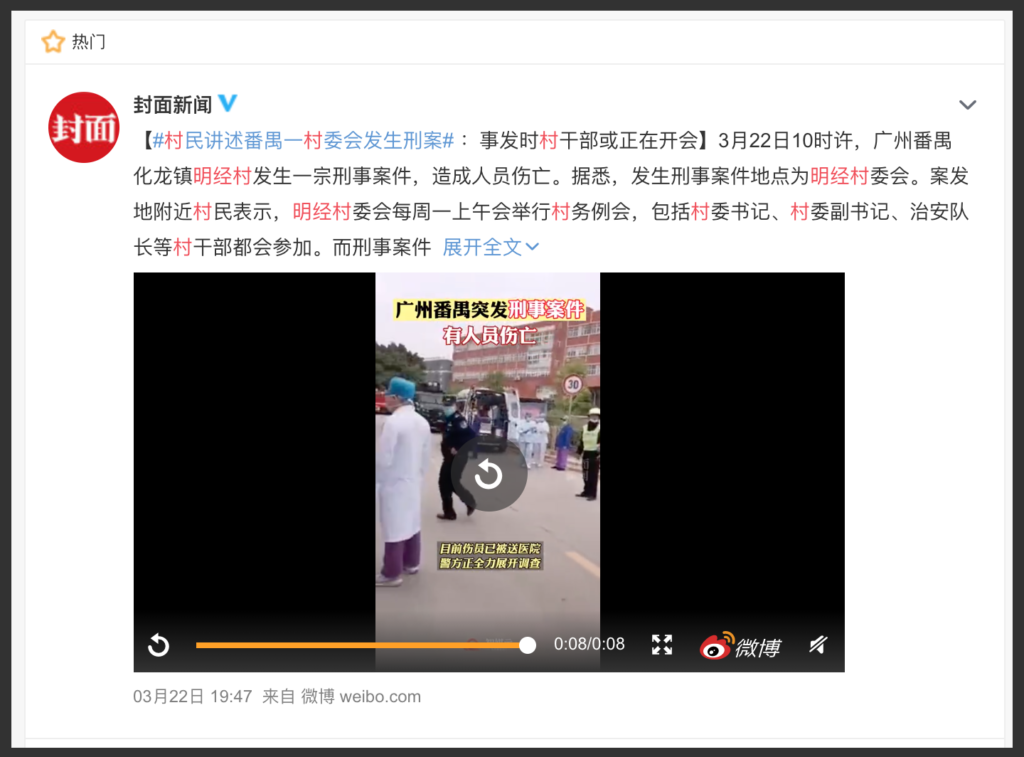
Hints of A Larger Story
By Monday night and into Tuesday, online reports on the explosion continued to focus sparsely on the details provided in the initial police notices, including the ambiguous reference to “a building structure.” Chinese media were reportedly under instructions to use only official media reports in referring to the incident.
From media in Hong Kong, however, we get a much fuller picture. The Apple Daily reports on page 17 today that the bombing in Mingjing Village is related to a major development project underway in the area that involves the Shanghai-based Shenglong Group, one of the country’s largest real-estate companies, which also has developments in the US and Australia. The project, which involves the renovation of Mingjing Village – which like hundreds of other villages in the area has a deep history – will create an area to showcase technology innovation, and has an estimated total investment of around 1.2 billion US dollars.
The founder and chairman of Shenglong Group, Lin Yi (林亿), was listed on Forbes’ “China Rich List” in 2017, but subsequently fell back in the listing of billionaires. He has made headlines in Australia with his backing of Aqualand in Sydney, which is operated by his son, Lin Shangjin (林尚景).
What exactly were the grievances of “Hu XX”? Why did he attack, if that is what happened, the meeting of the Mingjing Village Committee? How was the renovation project being handled? What arrangements were there for compensation of villagers, assuming that collective village land was being used for this major project? All of these questions point to a more significant story.
Given the immense restraints they face, we can hardly expect Chinese media to tell this story. Or can we?
In fact, the Shanghai-based outlet Jiemian (界面) did run a report yesterday under the tantalizing headline: “Criminal Case in Mingjing Village, Panyu, Guangzhou, Where the Partner Company for the Old Village Renovation is Shenglong Group” (广州番禺明经村发生刑事案件,该村旧改合作企业为升龙集团). The story drew a tentative line between the explosion yesterday and disputes over land use surrounding the project involving Shenglong Group.
Not surprisingly, given the subsequent instructions against reporting, the Jiemian story has disappeared from China’s internet, yielding a “404” error.

The same story at QQ has also now disappeared, resolving into a “404” error inviting readers to share information about missing children. (Is this QQ’s way of transforming censorship into public service?).

Sina.com too had apparently re-posted the story, only to remove it later, as the word came round that no reporting was to be done on the incident in Mingjing Village.

Fortunately, a cached version of the story as it appeared at QQ is still available. In fact, the story does not explicitly state a link between the explosion Monday and the planned village renovation project in Mingjing. But the implication of a connection is strong, and Jiemian even quotes Shenglong Group as saying that demolition work has not yet begun because the project is not far enough along. This clues us in to the fact that demolition and removal, and related compensation issues, are almost surely involved here.
Inside China, the stories from Jiemian and The Beijing News are likely as far as this story will now go. We include a partial translation of the former below.
Reporter | Huang Yu (黄昱)
At noon on March 22, police in Guangzhou’s Panyu issued a notice saying that at around 10AM on March 22, a criminal case occurred in Mingjing Village, Hualong Town, Panyu, Guangzhou, resulting in casualties. After the incident, Panyu police quickly sent officers to the scene to deal with it and cooperate with the local government to carry out rescue work in collaboration with fire and medical departments. The injured have been taken to hospital for treatment and the police are working hard to investigate the case.
Video of the crime scene circulated online shows the Village Committee [building] in chaos, the ceiling of the building collapsed by the impact of the shock wave, and people lying on the ground, with blood covering the walls and the ground. Firefighters, police and medical personnel are on the scene dealing with the injured.
Mingjing Village Collective Economic Organization has a total of 3,736 registered people, and is located in the middle of Panyu’s Hualong town, east of the Panyu Intelligent Network and New Energy Automobile Industrial Park, south of Tangshan Village, west to Guang’ao Expressway, north of Jinshan Avenue, with an excellent location. Not only is it near Guangzhou University City and the Guangzhou International Innovation City and other important areas, but the construction of the Guangzhou Automotive Value Innovation Park should also bring significant opportunities for the development of Mingjing Village.
In August last year, the Mingjing Village Old Village Renovation Project, with a total estimated investment of about RMB 8 billion, was voted by the member representatives of the Mingjing Village Joint Stock Cooperative Economic Society (明经村股份合作经济社), with Shanghai Shenglong Investment Group (hereafter “Shenglong Group”) as a partner.
According to official data, the total land area of Mingjing Village is 108.49 hectares, including 95.81 hectares for the residences of villagers and other uses, about 9.5 hectares for the village’s collective economic properties, and about 3.18 hectares of state-owned land.
It is reported that after the transformation, Mingjing Village will be planned around the Guangzhou Automotive Value Innovation Park, deepening the functional interaction and support with Guangzhou University City and Guangzhou International Innovation City, building an area of science and technology innovation support . . . .
Speaking to Jiemian, Shenglong Group revealed that since officially becoming a partner of Mingjing Village’s renovation, the company has completed the data survey of the village and now the whole project has reached the stage of preparation for the area plan, which is far from the stage of reform plan review – and so as of yet no demolition work has been carried out.




















